It seems we can’t find what you’re looking for. Perhaps searching can help.
Sign Up for newsletter!
Subscribe to get the latest eBook!
Hotline






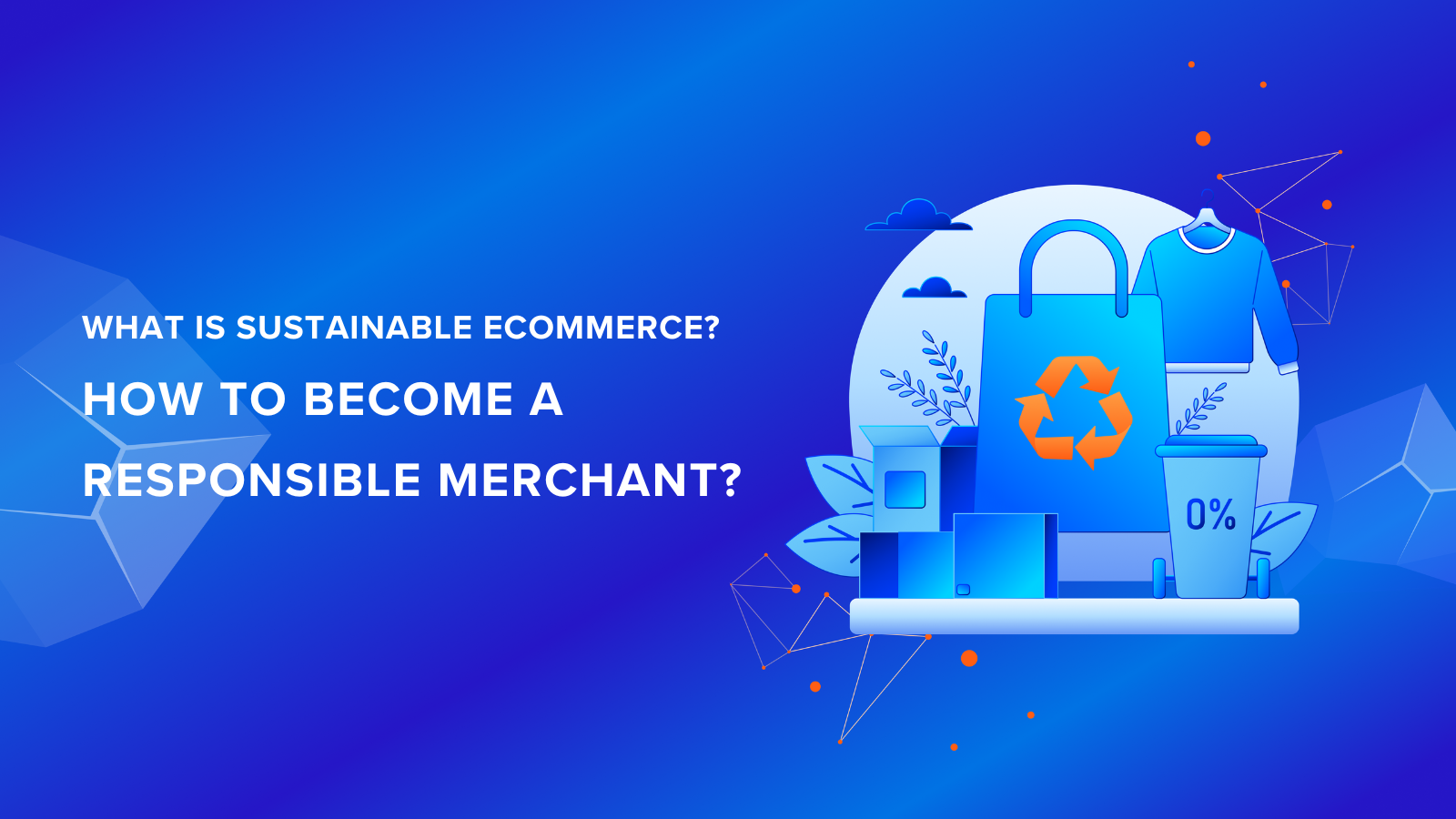
eCommerce has become an integral part of our daily lives, offering unparalleled convenience and access to a vast array of products. However, as the industry continues to grow, so does its environmental footprint. From excessive packaging waste to carbon emissions from shipping, the environmental impact of eCommerce cannot be ignored. This brings us to the concept of sustainable eCommerce—a transformative approach that seeks to minimize the negative environmental effects of online retail while promoting ethical business practices.
Sustainable eCommerce is not just a trend; it’s a response to the increasing consumer demand for environmentally friendly and socially responsible products. A survey shows that 72% of respondents reported that they were actively buying more environmentally friendly products than they did five years ago, while 81% said they expected to buy even more over the next five years.
In this blog, we will delve into the essence of sustainable eCommerce, explore its importance, examine the growing demand for it, and provide practical steps on how you can become a responsible merchant.
Sustainable eCommerce refers to the practice of conducting online business in a way that minimizes environmental impact and promotes social responsibility. At its core, it involves making mindful decisions at every stage of the business process, from product sourcing and manufacturing to packaging, shipping, and customer engagement. The goal is to reduce the carbon footprint, minimize waste, and ensure that ethical standards are upheld throughout the supply chain.
There are some common components in the eCommerce sustainability, including:
Offering products that are made from sustainable materials, are biodegradable, or have a lower environmental impact is crucial. This means choosing materials that are renewable, such as organic cotton or bamboo, over conventional materials that may deplete natural resources or cause pollution. Additionally, promoting products that are ethically sourced ensures that they are produced under fair labor conditions, respecting workers’ rights and contributing to social sustainability.
Sustainable packaging involves using materials that can be recycled, are biodegradable, or are made from recycled content. For instance, using cardboard boxes made from recycled paper or packing peanuts that are biodegradable can greatly reduce the environmental footprint. This approach not only minimizes waste but also appeals to environmentally conscious consumers.
Reducing energy consumption in the warehousing and logistics aspects of eCommerce is another critical component. This can be achieved by:
Minimizing waste throughout the entire eCommerce process is essential. This involves:
Ensuring that all business practices are ethical and transparent is fundamental to sustainable eCommerce. This includes:
By integrating these key components to strategies, eCommerce businesses can significantly reduce their environmental impact, support social responsibility, and meet the growing demand from consumers for more sustainable and ethical products.
Understanding the importance of eCommerce sustainability is crucial for businesses looking to thrive in today’s market. Here are several reasons why adopting sustainable practices in eCommerce is vital:
The environmental impact of traditional eCommerce practices is significant. From the excessive use of plastic packaging to the carbon emissions from shipping and logistics, the eCommerce industry contributes to environmental degradation. By adopting sustainable practices, businesses can significantly reduce their carbon footprint, decrease pollution, and help conserve natural resources. Sustainable eCommerce practices, such as using eco-friendly packaging and optimizing delivery routes, play a vital role in mitigating the industry’s environmental impact.
Consumer behavior is shifting towards sustainability. More and more customers are becoming environmentally conscious and prefer to purchase from brands that align with their values. Studies show that a growing number of consumers are willing to pay a premium for products that are sustainably produced and packaged. By adopting sustainable practices, eCommerce businesses can meet this demand, attract a broader customer base, and enhance customer loyalty. Being a responsible and eco-friendly brand can also differentiate a business in a crowded market.
Sustainable eCommerce practices can lead to significant business benefits. These include cost savings from reduced waste and energy consumption, improved brand reputation, and increased customer loyalty. Businesses that prioritize sustainability can also access new markets and opportunities, such as partnerships with other eco-friendly brands and certifications that can enhance credibility. Additionally, sustainable practices can lead to innovation, as companies find new ways to reduce their environmental impact and improve efficiency.
Governments and regulatory bodies are increasingly implementing stricter environmental regulations. Businesses that do not comply with these regulations risk facing fines, penalties, and damage to their reputation. By adopting sustainable practices, eCommerce businesses can stay ahead of regulatory changes, ensure compliance, and avoid potential legal issues. Proactively embracing sustainability also positions businesses as leaders in their industry, setting an example for others to follow.
Sustainability is essential for the long-term viability of businesses. As natural resources become scarcer and environmental issues become more pressing, companies that do not adopt sustainable practices may face higher costs and supply chain disruptions. By integrating sustainability into their business model, eCommerce companies can ensure they are resilient to future challenges and are better prepared for a changing market landscape. Sustainable practices also contribute to a positive corporate image, which can attract investors and stakeholders who prioritize responsible business operations.
Becoming a sustainable eCommerce business involves implementing practices that minimize environmental impact and promote social responsibility. Here are key steps to help you achieve sustainability:
Optimizing your supply chain is crucial for sustainability. This involves sourcing materials and products from suppliers who adhere to ethical and environmental standards.
Shipping is a significant contributor to the environmental footprint of eCommerce. Optimizing your shipping strategy can help reduce emissions and improve efficiency.
Packaging is a major source of waste in eCommerce. Switching to recyclable packaging can significantly reduce environmental impact.
Supporting environmental charities and initiatives can enhance your sustainability efforts and demonstrate your commitment to making a positive impact.
By implementing these strategies, your eCommerce business can significantly reduce its environmental impact, meet the growing demand for sustainable practices, and build a loyal customer base that values social responsibility. Adopting sustainability is not only good for the planet but also beneficial for your business’s long-term success.
Final words
eCommerce sustainability is no longer a luxury but a necessity. Consumers are increasingly prioritizing eco-friendly and socially responsible brands, and businesses must adapt to meet this demand. Embracing sustainable eCommerce practices, businesses can make informed decisions that contribute to a healthier planet.
 2
2
 2,166
2,166
 0
0
 2
2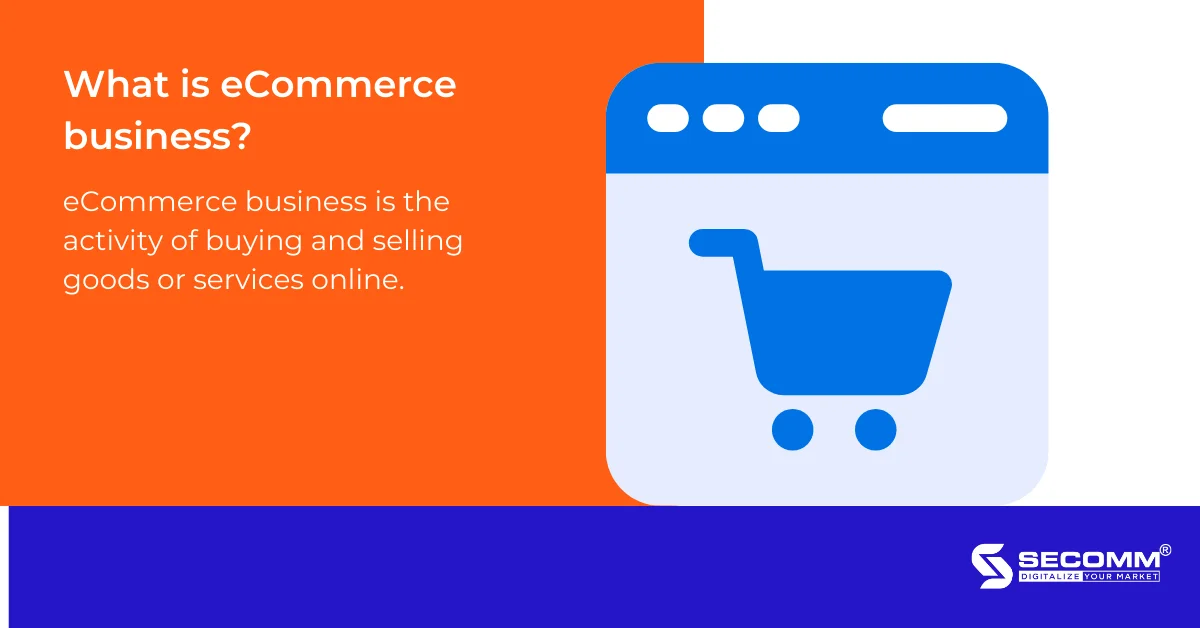
For businesses that are just entering the market, the term “eCommerce” is often recognized through eCommerce marketplaces. Most managers are often unsure of where to start, including which systems to use, which eCommerce platform to choose for development, and what steps to take next.
Therefore, in this article, SECOMM will share comprehensive information from basics to advanced levels to kickstart eCommerce business in Vietnam.
According to Decree No. 52/2013/ND-CP on eCommerce: “eCommerce activities involve conducting all or part of the commercial process through electronic means connected to the Internet, mobile telecommunications networks, or other open networks.”
In simpler terms, eCommerce business is the activity of buying and selling goods or services online.
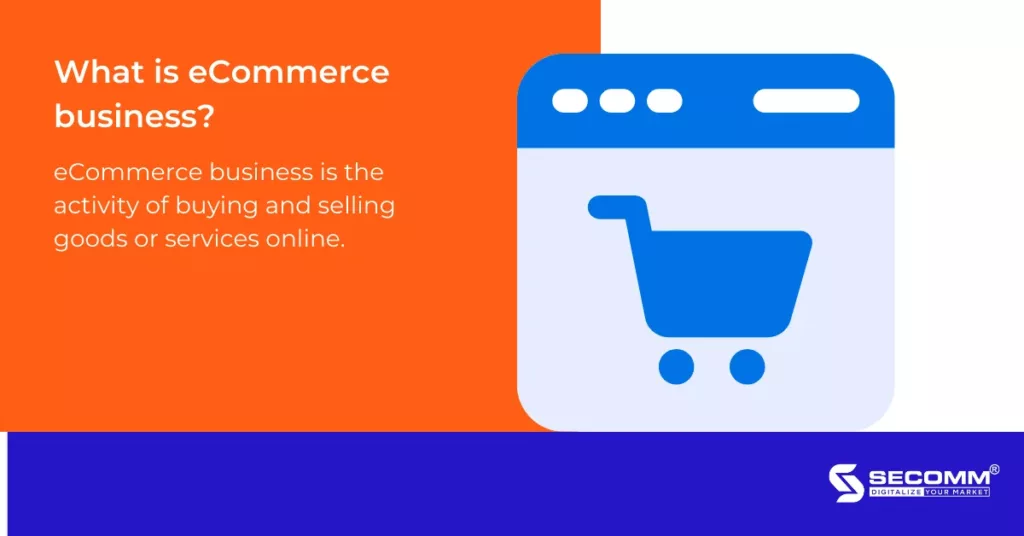
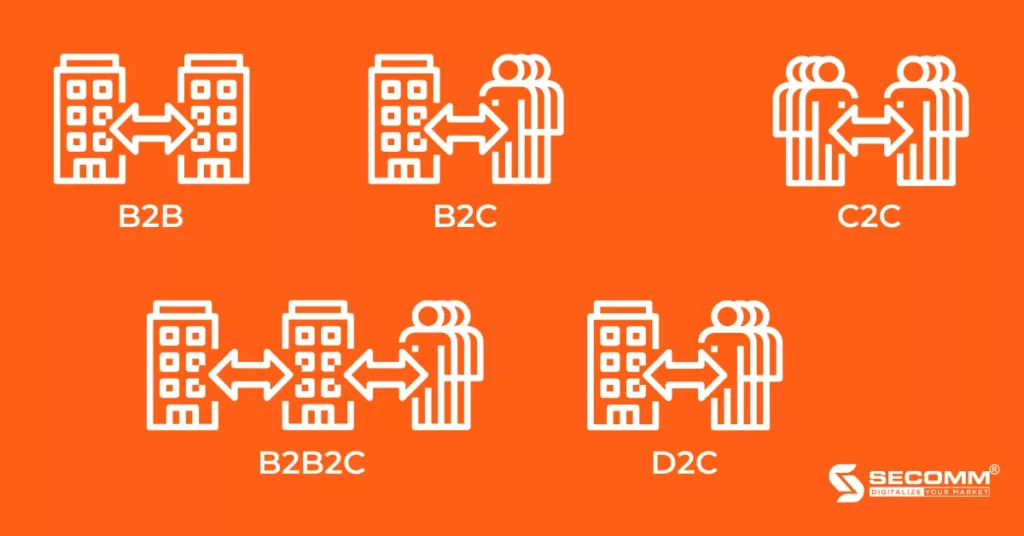
B2C (Business to Customer) involves transactions between businesses and customers. This is also the most common model in the Vietnamese market.
Example: Thế Giới Di Động is the number one retail model in Vietnam’s eCommerce market for devices such as phones, laptops, tablets, and accessories.

B2B (Business to Business) involves commercial transactions between two businesses.
Example: TELIO is Vietnam’s first B2B eCommerce platform, facilitating the connection between small-scale traditional retailers and brands by aggregating demand, providing more choices, better prices, and more efficient logistics support.

B2B2C (Business to Business to Customer) is a business model that involves collaboration between two businesses (B2B) to create and deliver products or services to end consumers (B2C).
Example: Shopee is the most popular eCommerce platform in Vietnam. Shopee Vietnam initially operated under a C2C model, serving as an intermediary in the buying and selling process between individuals. However, Shopee Vietnam has evolved into a B2B2C hybrid model by offering various services and conveniences to support the shopping process for both businesses and consumers.
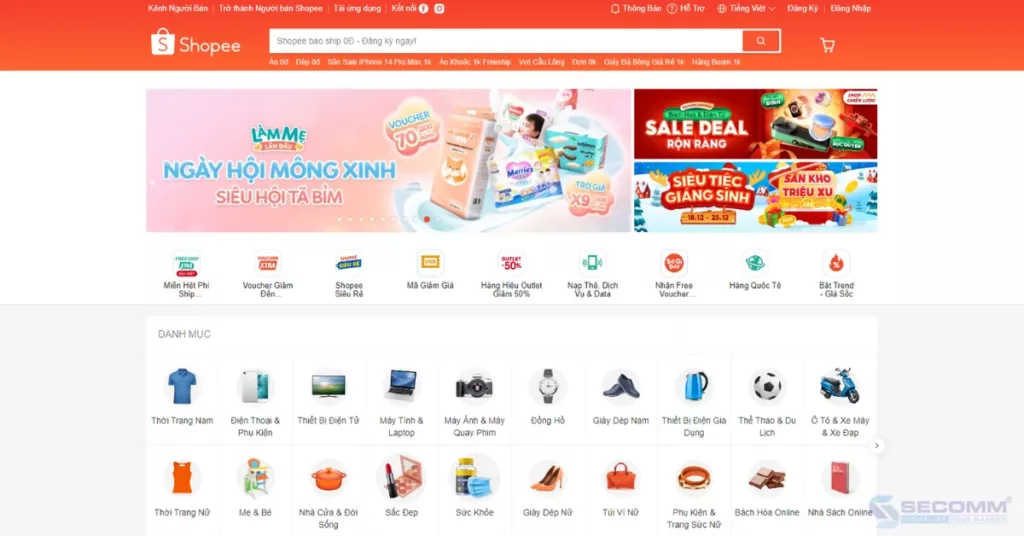
C2C (Consumer to Consumer) is a form of business where transactions occur directly between two individuals rather than involving businesses.
Example: Chợ Tốt is an eCommerce website that facilitates transactions between individual sellers and buyers for items such as real estate, cars, job postings, used electronics, pets, and various home services.

D2C (Direct to Customer) is a business model that delivers products directly from the business to the customer, bypassing intermediary distribution channels.
Example: Coolmate is a men’s fashion startup established in 2019. Within just 2 years of operation, the brand raised a rapid $500,000 in funding for Sharktank.
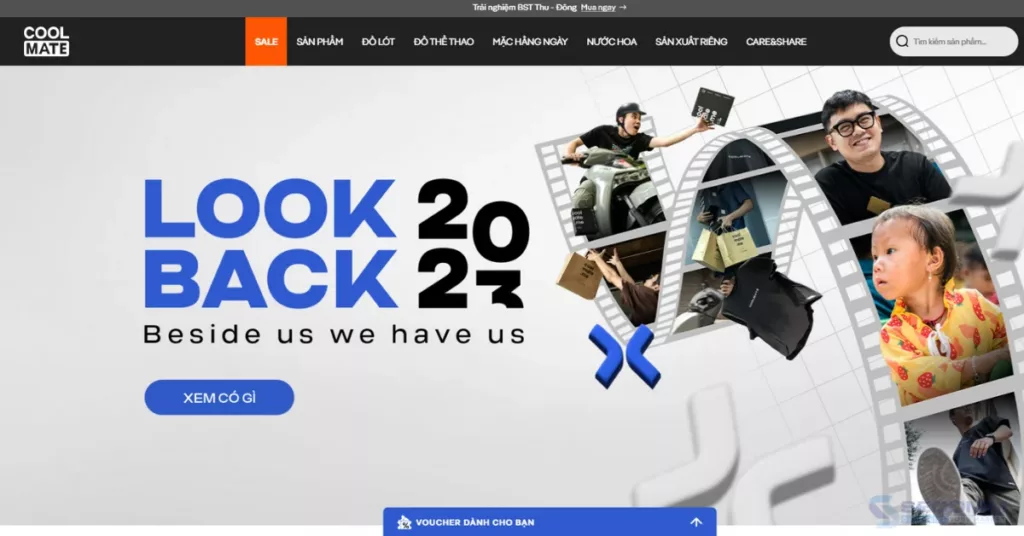
When starting to plan a business, the first step that managers should take is market research to understand the overall market situation, details about competitors, trends, and consumer behaviour. Some free and reputable sources businesses can refer to include the White Paper on eCommerce in Vietnam by IDEA, the e-Conomy SEA report by Google & Temasek, the eCommerce Index report by Vecom, etc.
After conducting market research, the next thing businesses should pay attention to is defining objectives, such as adding sales channels to increase revenue, positioning the brand in the eCommerce market, supporting marketing campaigns, enhancing user experience and interaction, etc.
Following market research and goal setting, businesses should also budget and plan the implementation timeline for each stage of eCommerce operations. Depending on the goals and strategies, each business will set budgets and timelines for the most effective eCommerce operations.
Next, businesses need to choose an eCommerce platform to build a system that aligns with the brand’s scale and strategy. The components of an eCommerce system typically include a website and an eCommerce website application.
There are two main types of platforms nowadays: SaaS (Software as a Service) and Open Source.
For Open Source platforms:
For SaaS platforms:
Once the eCommerce platform is selected, businesses have two options for resources to build the website: building an in-house team or using services from developers.
For building an in-house team, businesses need to recruit and train IT and eCommerce professionals with expertise and experience on the chosen platform. This process may take time and budget to build a suitable team but provides better control over resources, allowing adjustments or developments according to specific requirements.
For collaborating with development firms, businesses should seek developers based on criteria such as deep experience in eCommerce, an experienced team, a clear process, quick handling and support, and commitments to warranty and maintenance. This approach helps businesses gain professional expertise, enhance experience, and develop a suitable website.
In the eCommerce market, there are various payment methods, with Cash on Delivery (COD) being the most common. However, due to the rise of “cashless” payment trends amid the Covid-19 pandemic, electronic payment methods are gaining more prominence.
Some payment methods chosen by eCommerce businesses include:
Usually, a fulfilment process includes the following steps: Importing goods or manufacturing → Shipping to warehouse/distribution centre → Warehousing → Processing goods upon request (Shipping, invoicing, packaging, labelling) → Delivery → Handling post-sale requests (Returns, refunds, exchanges).
Therefore, a comprehensive eCommerce system needs to build or integrate functionalities such as eLogistics, blockchain, QR codes, etc., to automate the shipping process, track orders, and thereby enhance the quality of delivery to end consumers.
A Customer Relationship Management (CRM) system is an essential component in the operation of eCommerce businesses. Building and continuously improving the CRM system, as well as implementing a multi-channel customer care centre, helps expedite the processing of complaints, returns, and refunds. Additionally, a CRM system assists businesses in gaining insights into customer needs, facilitating the establishment of interactions between the brand and its customers.
Maintaining the eCommerce system 24/7, continually updating and upgrading it helps businesses promptly address arising issues, achieve sustainable sales growth, and adapt quickly to the ever-changing market. Simultaneously, continuous monitoring and maintaining eCommerce operations aim to prevent risks from hackers, data breaches, etc.
One of the crucial strategies in current eCommerce operations is omnichannel selling. By following customers’ “footprints” across eCommerce platforms (Shopee, Lazada, Tiki, Sendo), social media (Facebook, TikTok, Instagram, Zalo), websites, and eCommerce apps, this strategy centralizes customer data, reaches diverse shopping behaviours, and optimizes personalized experiences in the eCommerce system. Additionally, various eCommerce marketing campaigns are being developed, such as Affiliate Marketing, Shoppertainment, SEO, Email Marketing, etc. This strategy optimizes brand visibility and boosts online sales.
Building reporting functions to exploit the efficiency of data, including reports on Sales, Marketing, Customers, Inventory, and Operational Performance, to improve and enhance business efficiency. Integrating analytical tools such as Google Analytics, Facebook Pixels, Microsoft Power BI, etc., supports tracking and measuring system performance to provide detailed reports on business results in eCommerce.
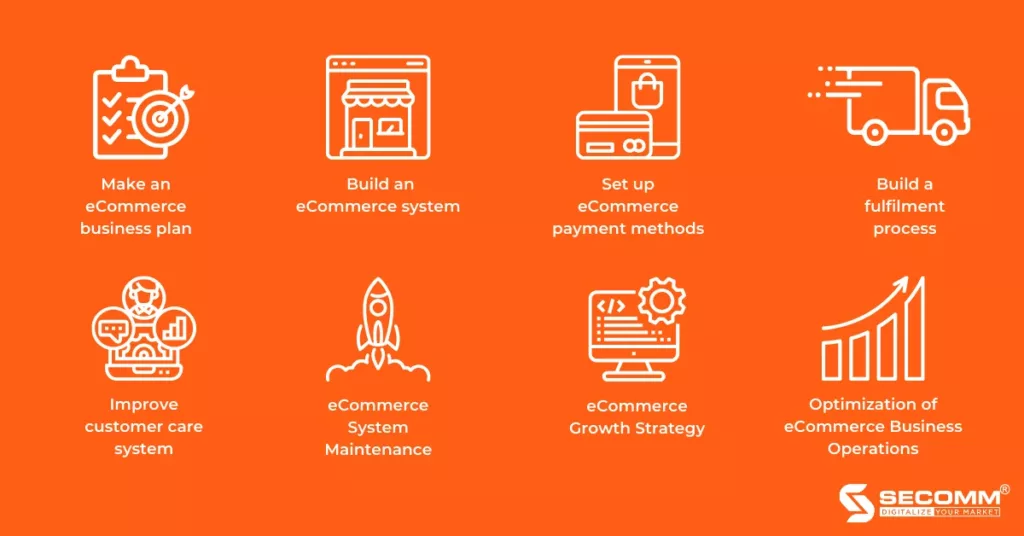
In summary, conducting eCommerce based on the above 8 steps is not an easy task for business managers. To stay competitive in the eCommerce race, various factors come into play, including financial strength, human resources, the general economic situation, changes in consumer behaviour, etc. Therefore, managers need to be cautious when making critical decisions to bring business efficiency.
With over 9 years of experience in designing complex eCommerce systems for companies like Annam Gourmet, Laybyland, and Jasnor, SECOMM understands the challenges businesses face in researching and efficiently implementing eCommerce.
Contact SECOMM now for free consultation on detailed eCommerce system development solutions!
 2
2
 16,055
16,055
 0
0
 1
1
eCommerce has become an essential business model that fashion brands must utilize not only to survive during the COVID-19 pandemic but also to assist companies in adapting to changing customer behavior, providing competitive advantages for future breakthroughs.
As a result, fashion eCommerce has become a crucial business trend for many fashion businesses today, from start-ups to “giant” corporations.

According to Statista, the compound annual growth rate (CAGR) of the fashion eCommerce market is predicted to be 14.2% from 2017 to 2025. The CAGR is forecast to reach a value of USD 1 trillion by 2025, in which the US market accounts for about 20%, equivalent to 204.9 billion USD.
In the Vietnamese market, fashion eCommerce is the second most important sector, just after eGrocery (The Vietnam eCommerce White Paper in 2021).
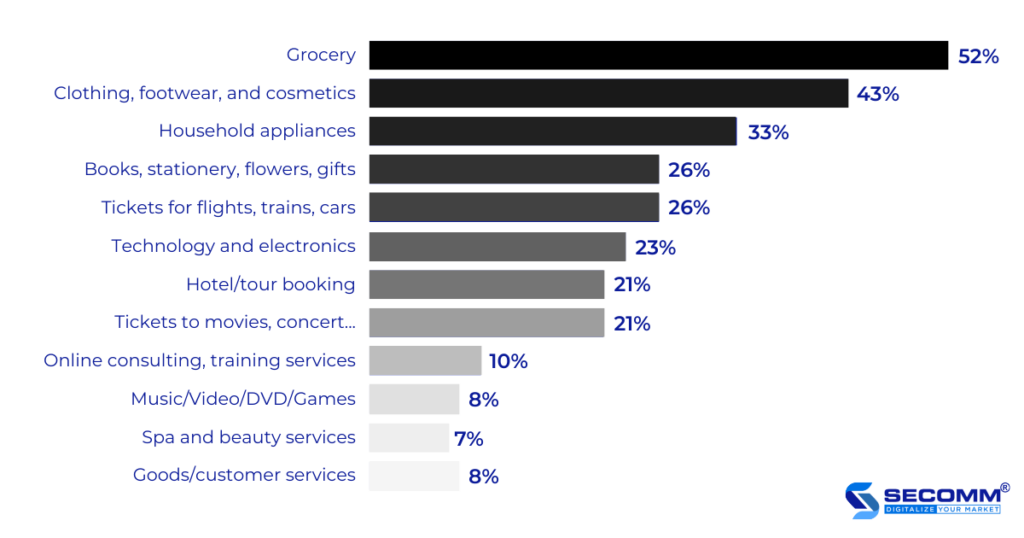
The use of eCommerce will provide fashion firms with a new sales channel, along with offline commercial activity in showrooms. For geographical factors, eCommerce transcends place and time to allow customers to purchase whenever and wherever they choose.

Simultaneously, eCommerce is a prominent avenue for reaching customers, particularly in the sphere of fast fashion for women. Marketing activities such as Livestream, Shoppertainment (Shopping with entertainment), Affiliate, and so on are more effectively carried out, leading to the extension of the commercial scope for enterprises.
Following the COVID-19 epidemic and the social distancing order, consumer behavior has shifted dramatically, with the transition from physical to online buying rising over time in all categories. In the fashion business alone, the percentage of online customers climbed from 18% to 48% in 2020–2021. As a result, it is critical for fashion businesses to implement eCommerce.
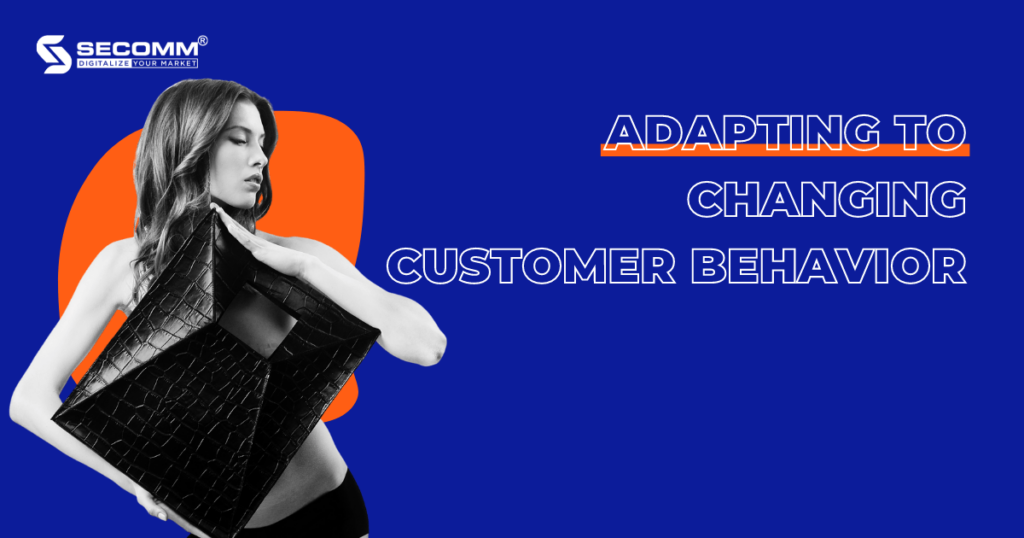
After the epidemic, consumer behavior altered drastically, such as waiting until D-Day to purchase items. Furthermore, by utilizing eCommerce technologies, organizations can follow, analyze, and synthesize the consumption behavior of each target group, something offline purchasing cannot accomplish. This ensures that businesses always have enough aggregated and forecasted data to implement business plans.
2.3. Improve the user experience
When technologies that improve user experience in e-commerce are used, customer purchases will be made faster.
Visual experiences such as photos, movies, virtual reality experiences, and so on provide customers with full product information and expertise, enabling a speedier purchasing process. VR / AR technology enables people to shop for garments, accessories, and shoes online in the same way they would in a store.
For example, the American Apparel company has used AR to show shoppers more product information, like detailed descriptions, availability, colors, and buyer reviews.

eCommerce allows businesses to tailor the experience for consumers by collecting, evaluating easily, and summarizing the consumption habits of each target group, often with the following features: Recommend products, Products seen, and so on.
eCommerce provides a seamless experience for customers across many channels such as social media (Facebook, Instagram, Tiktok, Zalo, etc), eCommerce marketplace (Shopee, Lazada, Tiki, Sendo, etc), eCommerce website, and mobile app.
Shein is a Chinese eCommerce site created in 2008 that specializes in apparel and accessories. With the motto “everyone can enjoy the beauty of fashion,” the company pushes to give consumers a diverse selection of product options. Shein is currently regarded as a fashion “empire” with a valuation of $ 100 billion – more than Zara ($ 69 billion) and H&M (23 billion) combined.

Shein focuses on the youthful client sector of Gen Y and Gen Z, who use the Internet often. As a result, this brand has used technical components to reach more consumers in an appropriate and exact manner.
Shein created an eCommerce system that included a website and a mobile app to target overseas markets such as Europe, America, Australia, and the Middle East. Shein then advocated Social Commerce, Ecommerce Marketing, Affiliate Marketing, KOC, and other tactics to improve brand awareness and engagement.
In 2021, Shein’s mobile app exceeded 7 million monthly active users in the US alone (Airnow Data), and the hashtag #Shein garnered more than 10 billion views on TikTok (Jing Daily). Revenue reached $15.7 billion in 2021, up 60% from 2020 ($9.8 billion). It can be seen that Shein is a clear example of the effective application of eCommerce to capture market share in the fashion industry.
Coolmate is a menswear startup that was established in 2019. Coolmate is a mix of the words “cool” and “mate,” which means that the brand’s major purpose is to be a fashion buddy for customers. After barely two years of operation, this company received a $500,000 funding call from Sharktank Vietnam.
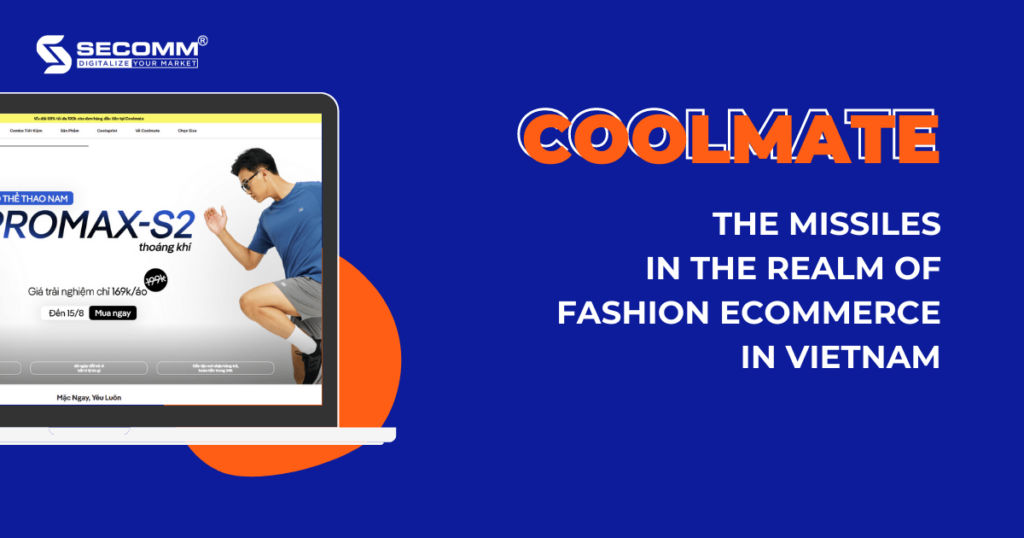
Coolmate utilizes the Direct to Customer Ecommerce (D2C eCommerce) model and concentrates on developing its own fashion website to provide a quick and cost-effective buying experience. At the same time, this brand prioritizes product quality, which is 100% made in Vietnam and meets export standards at low costs. Furthermore, to implement e-commerce faster, Coolmate advocates thoroughly apply the strategy of Ecommerce Marketing, Affiliate Marketing, Email Marketing, etc.
Aside from the $500,000 agreement for a 12.5% interest, 2.5% of the consultancy shares pledged, this fledgling business has other noteworthy statistics. Coolmate’s sales will reach VND 139 billion in 2021, up 3.5 times from 2020, with revenue expected to reach VND 440 billion in 2022 and an IPO (Initial Public Offering) by 2025. In general, eCommerce has considerably contributed to Coolmate’s development, as well as providing the groundwork for fashion businesses to follow to grow by market trends.
Yody (previously Hi5) is a family apparel label that was founded in 2014. To provide Vietnamese fashion goods made of high-quality materials to customers in various regions of Vietnam and throughout the world. Yody now employs over 700 people and has 90 outlets around Vietnam.
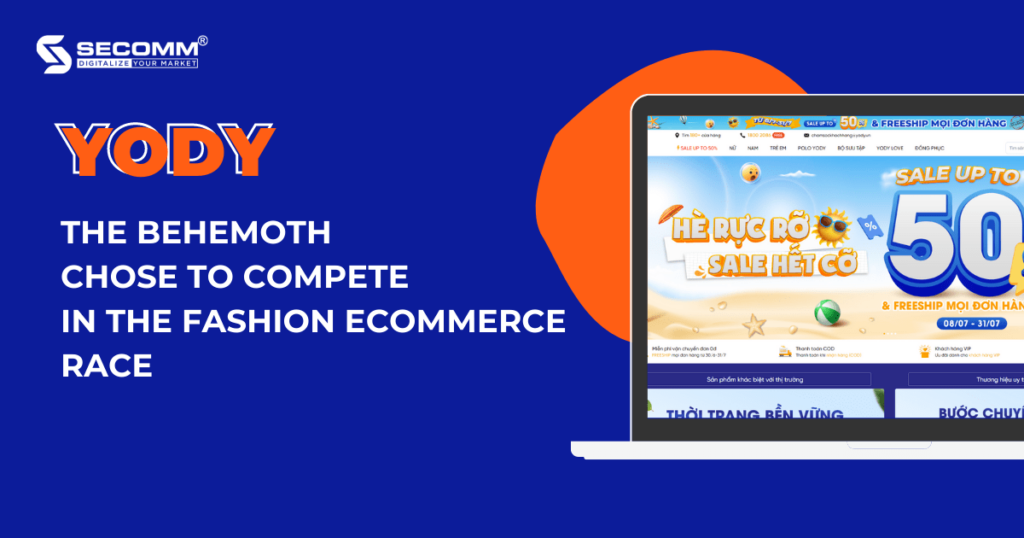
This fashion brand prioritizes the “tripod” of human resource development, product quality, and technology investment. Yody focuses on talent recruiting and culture training to engage employees in human resource development. In terms of products, Yody designs for comfort and convenience, and can be utilized in various situations, such as going to work, going out, attending meetings, and so on.
Regarding technology, Yody focuses on implementing an online sales strategy across Omni-channel such as eCommerce marketplaces, an eCommerce website, Facebook, Livestream, and so on to compete in the eCommerce race, as well as adapting to changing consumer behavior.
In 2016, Yody was selected as one of the ten outstanding young start-ups in Vietnam. By 2021, Yody’s physical sales will have dropped by 65%, but the internet segment has increased by more than 10%. Therefore, the company continues to aim to increase online revenue by 20% in the next year.
In a nutshell, how to apply fashion e-commerce will depend on the size and strategy of each company, but eCommerce is a prerequisite for successful business in this industry.
 2
2
 6,264
6,264
 1
1
 1
1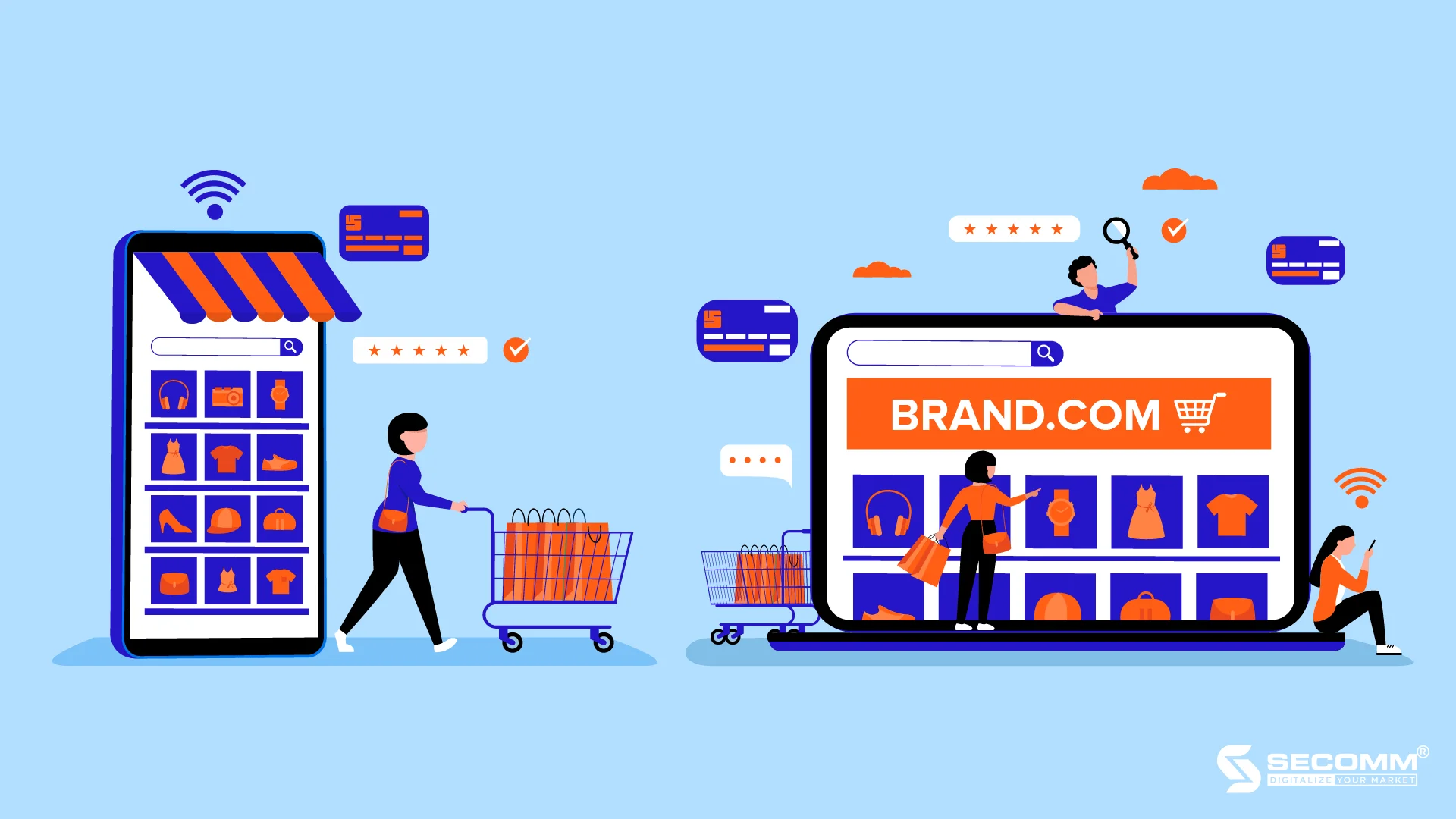
Branding plays a crucial role for businesses, especially in the e-commerce market. An effectively built brand in the e-commerce market helps customers recognize and favor the brand, leading to a tendency to shop on e-commerce websites and become loyal customers in the long run. Building a brand on an e-commerce website is the key to sustainable growth for businesses in this market.
Here are 10 prominent trends in building brands on e-commerce websites applied during the current ‘new normal’ era!
One of the most important tasks for any business during development is to establish a unique style for the brand, especially on e-commerce websites. …Creating an impression in the consumer’s mind helps customers distinguish the brand’s products from competitors. Simultaneously, establishing a unique style creates consistency across all products/services that the e-commerce website provides.
Mobile World Investment Corporation (MWG) has designed a logo and layout with characteristic imagery and uniformity across all e-commerce websites of its brand chain, such as The Gioi Di Dong, Dien May Xanh, Bach Hoa Xanh, Nha Thuoc An Khang. This helps customers of one of the four brands to recall the other brands within MWG.
Brand storytelling is a method to attract customer attention to a brand through the brand’s origin story and promoting the brand’s mission and vision. Sharing brand stories on e-commerce websites helps businesses create a connection to customers’ awareness.
With the goal of creating a brand image through storytelling, the ‘Coolmate Story’ section on the e-commerce website is built based on its name ‘Coolmate,’ with ‘cool’ symbolizing the cool, dynamic appearance of men and ‘mate’ symbolizing the brand’s mission – to be a companion in men’s fashion. Building a story about a fashion brand for men has made Coolmate’s e-commerce website a popular online shopping destination for young male customers in Vietnam.
The trend of building a “made-in” Vietnam brand is not unfamiliar to customers, from supermarkets with the motto “Vietnamese people use Vietnamese products” to the branding method of “Proudly Vietnamese Brand” appearing on e-commerce websites of Vietnamese brands such as Vinfast, Gumac, Highlands Coffee, etc. … Eliciting pride in the Vietnamese nation and calling for support from customers.
The branding strategies of Biti’s, especially for the Biti’s Hunter product line, are always closely associated with the “made-in-Vietnam” message. When launching the online store https://bitis.com.vn, Bitis also subtly incorporates national elements into every corner of the website, such as images, product information, banners, and blog posts.
Brand positioning associated with community benefits, such as supporting charities, donations, non-profit sales, or becoming a brand that encourages support… Building a brand through charitable activities helps enhance the company’s image in the eyes of consumers, promoting online shopping support on the brand’s e-commerce website.
Vinamilk is always a pioneer in social responsibility activities. Vinamilk has established several community funds to support activities to improve nutritional knowledge, healthcare, and improve clean living environments for surrounding communities, such as the School Milk Program (since 2006), the Vietnam Tall Milk Fund, the 1 Million Green Trees Fund for Vietnam. These messages are consistently conveyed on the company’s website.
By designing the brand or product lines displayed on e-commerce websites in line with the environmental protection trend, brands can increase public and potential customer sentiment.
Cocoon, a cosmetics brand from Vietnam, has successfully built the “Eco-Friendly” brand image on the current e-commerce market. The “Eco-Friendly” element of Cocoon is immediately shown in the website’s title tag as 100% vegetarian cosmetics. The content on the website consistently emphasizes the brand’s direction of environmentally friendly cosmetics, sourced from natural ingredients, not tested on animals, and certified by international organizations. Thanks to this, Cocoon has successfully positioned the “Eco-Friendly” brand in the hearts of Vietnamese beauty and nature lovers.
This is a new trend that helps brands maintain their values but adapt their business direction to fit the new normal period, such as:
F&B shifting to cloud kitchens, Travel companies offering touchless and virtual tours…
Changing business models have breathed new life into brands, creating a transformation for the brand. This stimulates curiosity about the brand’s changes among customers.
National Geographic – U.S. National Geographic Society has developed a virtual tour of Vietnam’s Son Doong Cave on its website, combining augmented reality (AR) virtual reality (VR) technology. This achievement not only contributes to the attractiveness of Son Doong Cave but also enhances the brand position for National Geographic, becoming a case study for many famous travel websites about virtual tours.
Consumers today are becoming more discerning and will not easily accept low-quality products on the e-commerce market.
Building a brand that focuses on a few high-quality products on the e-commerce website can make customers loyal to the brand and enhance the brand’s reputation.
3 Sach Food, a brand that focuses on providing clean, chemical-free, non-stimulant, and preservative-free products, has successfully attracted a group of customers interested in the quality of food. Thanks to the focus on product quality, 3 Sach Food has successfully attracted the attention of customers interested in food quality.
Content contributes to developing the relationship between the brand and customers.
Building content with the potential to spread among customer groups will help the brand establish a faster image in the eyes of consumers.
With the goal of building viral content, CellphoneS focuses on updating dramas, hot news, reaction videos, etc., to attract the attention of the youth on the blog website and cleverly embeds technology products, encouraging shopping activities.
To connect emotionally with customers, businesses need to speak their language.
Responding to customers in the language they use for communication will help them react more quickly to brand marketing campaigns and contribute to leaving a more positive impression after brand-building efforts.
Durex, dubbed the ‘content saint’ in the marketing world, always impresses people with its ability to creatively create content using customer language even on the e-commerce website. Applying customer language not only helps the brand increase sales growth but also becomes a companion in every ‘love affair’ of customers.
Brand positioning through digital brand experiences, integrating automation, AI, and virtual reality VR, is considered a new trend for ecommerce businesses. Increasing touchpoints for the brand on e-commerce websites through enhancing the customer experience.
Fitin provides a completely new furniture shopping solution for customers on the e-commerce website and mobile app by integrating 3D technology: VR, AR, Homestyler. Thanks to this, customers not only experience new, professional shopping but also contribute to affirming the position of the Fitin brand in the furniture industry in the eyes of consumers.
Doing ecommerce business in Vietnam is undoubtedly a long-term game for any business entering this market. To develop sustainably, building a brand on e-commerce websites is a prerequisite that cannot be ignored. However, building a brand on eCommerce websites is still a relatively new story for many businesses in Vietnam.
To inquire about free consultation on eCommerce solutions, please contact SECOMM for expert advice.
 2
2
 5,140
5,140
 0
0
 1
1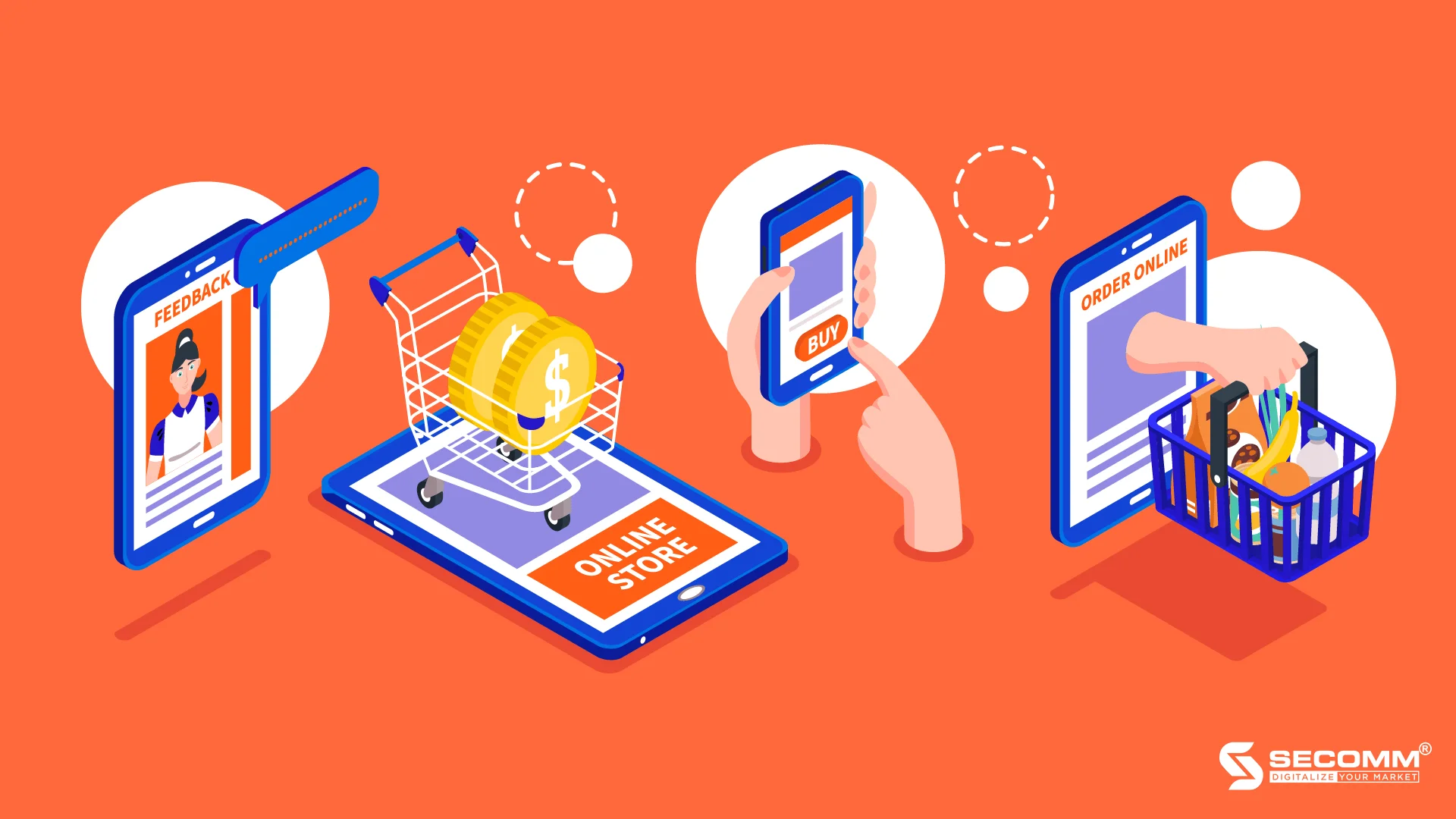
To gain a competitive advantage in the Ecommerce market, businesses need a detailed strategy outlining the transition stages and implementation measures for each stage. Determining an Ecommerce business strategy helps provide a comprehensive view of the market, business products, and brand development potential. Below is an Ecommerce business strategy for businesses to reference and guide their operations.
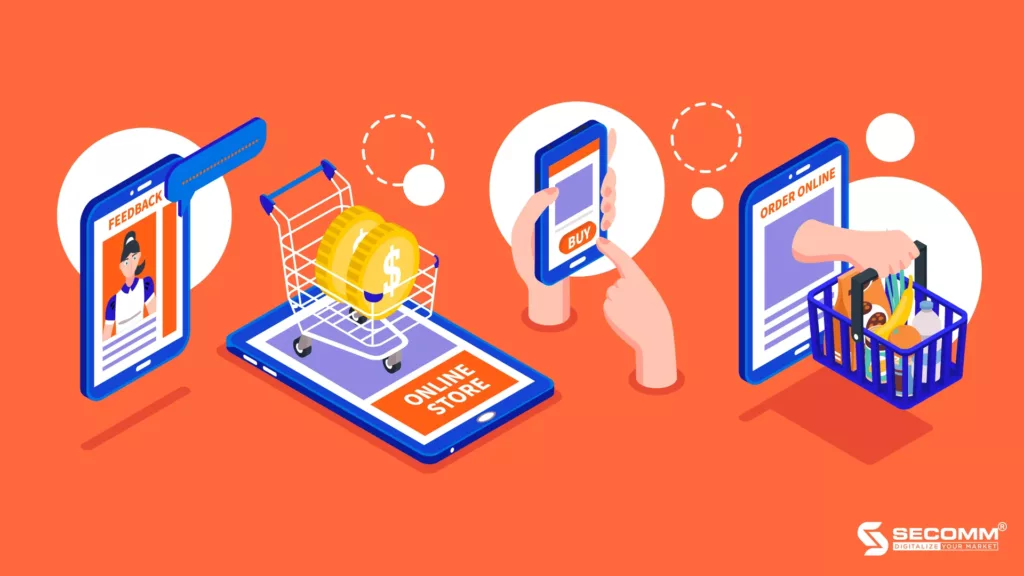
Transition the traditional business model to online business on popular social media platforms. This stage allows businesses to test the viability of their products in the online market. Conducting business on social media helps save costs, increases reach, and enhances interaction with customers.
Support Platforms: Facebook, Instagram, TikTok, Zalo.
Business Process on Social Media:
Officially join the Ecommerce game by establishing an online store on Ecommerce Marketplace. Utilize existing customer groups on these platforms and leverage support utilities to improve customer services, such as payment services, delivery services, and marketing services.
Support Platforms: Shopee, Lazada, Tiki, Sendo.
Business Process on Ecommerce Marketplaces:
STAGE 3: BUILDING AN ONLINE SALES WEBSITE
Build a website to position the brand in the online market, utilize search tools to reach a larger potential customer base, and provide business and product information.
Popular Platforms: Wix, Weebly, Spacesquare.
Website Building Process:
Designing an Ecommerce website helps businesses expand their online sales channels, connect with more customers, and increase brand coverage in the market. Having a proprietary Ecommerce system allows easier data exploitation and reduces dependency on data from other Ecommerce platforms.
Support Platforms: Sapo, Haravan, Shopify, WordPress, Magento, Bigcommerce, Woocommerce.
Basic E-commerce System Building Process:
Developing an in-depth Ecommerce system helps maximize Ecommerce revenue, allows easy system upgrades and customization based on specific needs, and introduces new features to enhance the customer experience.
Platforms: Magento, Bigcommerce, Woocommerce.
In-Depth E-commerce System Building Process:
Implementing Omni-channel helps synchronize all sales channels for easier data management and maximizes Ecommerce business efficiency. Omni-channel creates a seamless experience for customers, allowing businesses to sell through multiple channels and increase conversion rates.
When implementing Omni-channel, businesses can use service providers like ETP Group, NEF, Goell, or choose a centralized system like Magento, ERP.
Omni-channel Implementation Process:
The journey from Social Commerce to Omni-channel is a common strategy for businesses entering the E-commerce market. However, E-commerce has become increasingly popular in all industries, whether Low-involvement or High-involvement. Many businesses deploy social media channels, Ecommerce platforms, and proprietary E-commerce systems early on to shorten the conversion time, keep up with market trends, and meet the diverse needs of customers.
Depending on the overall business strategy and current situation, each business needs to plan the most suitable development roadmap!
Contact SECOMM for free consulting!
 2
2
 11,725
11,725
 0
0
 1
1Subscribe to get the latest eBook!
Hotline